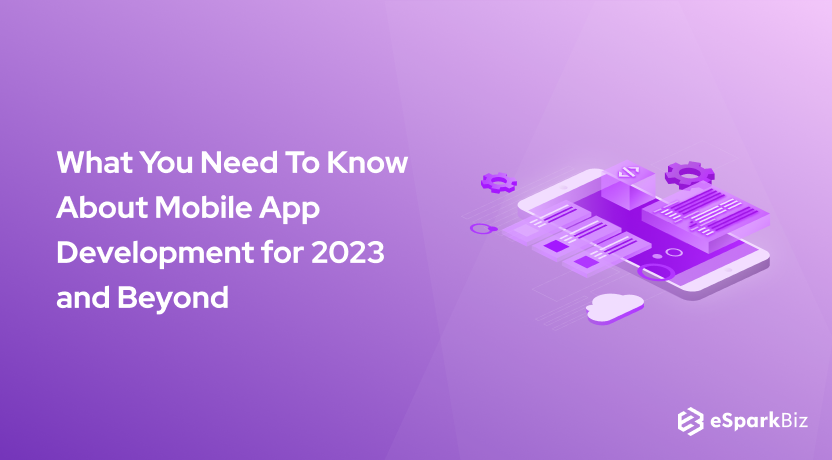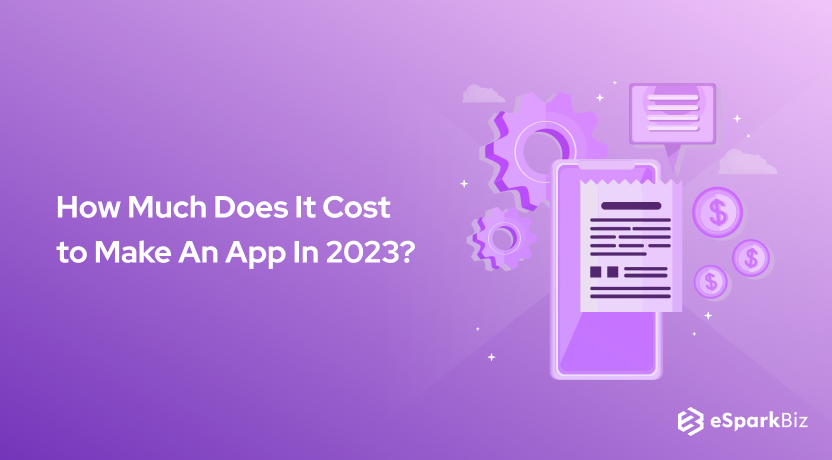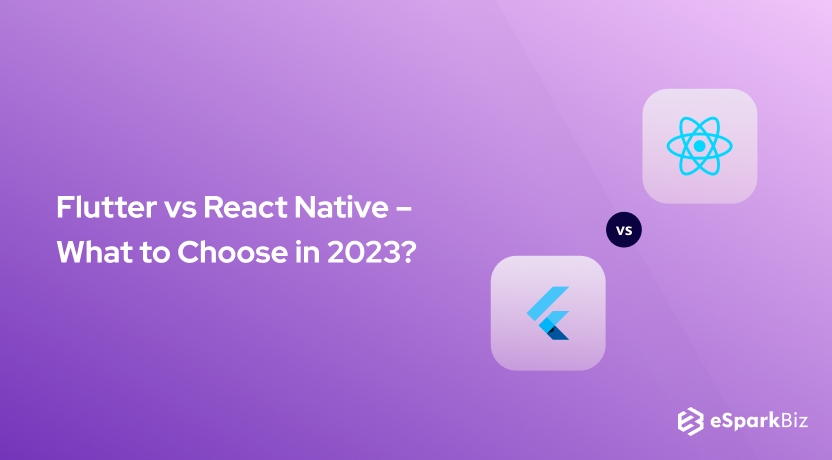Mobile application development is one of the most popular methods of software creation and is continuously evolving with the increased popularity of smartphones and tablets.
“What You Need To Know About Mobile App Development for 2024 and Beyond” is a complete in-depth guide about mobile app development including the following topics:
Let us dive into the details of each section one by one.
What Is Mobile App Development?
To define it technically, a combo involving a set of processes and strategies for writing software for small and wireless computing devices is mobile app development.
Since mobile app development includes software development on the basis of mobile devices, it tries to take the complete advantage of the device’s exclusive features.
What Is The Purpose Of a Mobile App?
Mobile App Development, with an indefinite purpose or inability to cope up with a range of changes, is a waste of money. App development should be tied to a goal. If not done, turns up to be a failure.
The main reasons that accord to the failure of a mobile app is confusion and inability to target the audience to find a place in the market.
While developing a mobile app, and making your app a successful one, your app should fulfill the following three categories of purpose. If your app can fall for at least one of the types mentioned below, you will have a positive return on investment.
Category 1 – A Solution Provider And a Problem Solver
Generally, the scenario that I have witnessed from the customer side:
- Interaction with you
- Purchasing from you
- Booking with you
- Involved in business with you
What will be more befitting than making these processes easier for the customers❓
The primary purpose of having a mobile app in spite of a website is its fast speed and ability to run without the Internet. Your app helps you solve many problems on-the-go.
Europe’s leading Train and Coach App, The TrainLine App, provide departure boards, price alerts, seat preferences, favorite routes, ticket details, and many more.
Category 2 – The ‘Entertainment’ Factor
The apps with the ‘entertainment’ factor excel globally due to their charm across a wide range of orbit of age and their capabilities.
Angry Birds, Candy Crush-Minecraft, come under this genre and have adopted this mantra for their success. They are free, to begin with, and at a later stage provide options for paid plans.
Category 3 – Adding Value
Some apps serve every day’s purpose like multi-location meetings. The apps under this genre add value to the services. For Example, Skype- you can share your screen, call, chat, video call, have a conference call, and so on.
What Affects Mobile App Development Costs?
Now you are ready to transform your mobile app idea into reality.
But wait a minute!?
You aren’t a genius coder, and none of your friends are available at this moment to help you out. In such a case, you have to hire a mobile app development company for making your dreams come true, and this is expensive.
Do these questions bother you?
How expensive is hiring a mobile app development company?
How much does it cost to build an app?
How much time does it take to build an app? ⏳
How would you fund your mobile app?
If yes, we are here to answer your queries in the following sections, one-by-one.
Are a few sets of the questions that I will be answering you in the subsequent sections one by one.
What Are The Different Types Of a Mobile App?
Mobile apps are designed and developed with multi-aspect programming languages and various frameworks.

I have tried to categorize into three main classes:
Native Apps
These apps are created for a specific platform, e.i., for iOS or Android. The languages used for developing the apps are supported by these operating systems.
The development tools are completely supported by these platforms. Xcode and Objective-C are used by iOS, Eclipse and Java are Android’s forte.
HTML5 Apps
If you are interested in a write-once-run-anywhere approach, then HTML5, Javascript, and CSS are all that you need. The benefits of apps developed with this framework are:
- Compatible for cross-platform
- Minimum charges for development
- Each operating system explores complete functionality
Hybrid Apps
Normally with hybrid apps, embedding an HTML app is possible through container creation. This is developed in the native system. Hybrid apps authorize the usage of enlarged operations of unique elements for each native system.
Some interesting facts about mobile app development growth
- 6,140 apps are released every single day – Statista
- A whopping $189 billion mobile app revenue is forecasted for 2020.
These interesting figures show a great impact on the mobile app development industry. If you look back, there are witnesses proving the rise of the number of apps flooded the Play Store and Apple Store.
With the trending technologies integrated into the mobile app, there has been a lot of change in the mobile app development process.
So the next question that I will answer is…
How To Create a Mobile App?
The mobile app development includes the following steps
- Market Research and Tech-Stack
- Defining Mobile App Goals and Objectives
- Wireframing the App
- Defining the backend of the Mobile App
- Finalize your wireframe and test your prototype
- Develop the App
- Test Again
- Launch Preparation
- Official Release
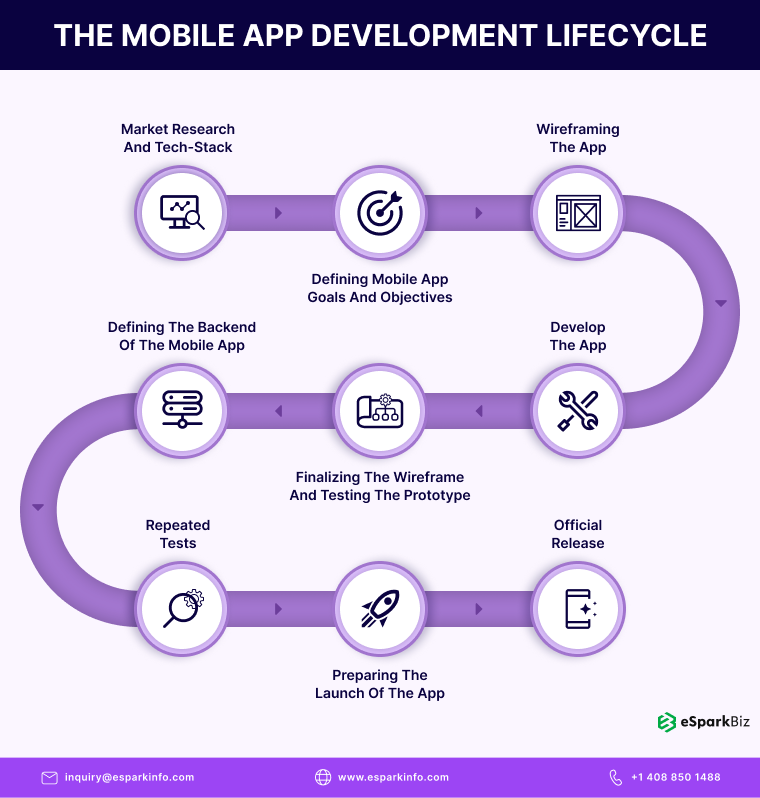
Let us dive deep into the details.
Market Research & Tech-Stack
I am sure you have an excellent mobile app idea and hence you are here to read this blog.
So have you planned the steps??
How would you begin??
Direct design and development are not feasible at all if you are thinking of this. The first phase before you go to the design and development phase is market research.
The research will help you to find your target audience and your position against the competitors in the market. While doing research look for answers of the following question:
- What should be accomplished by your mobile app?
- Is your mobile app good enough to find a fit in the mobile marketing plans?
- Which set of the audience are you planning to target?
- How have you thought to make your app usable for the customers?
- Which platforms will you use?
- Which mobile app development language and framework will you use?
- The app is ruling? What kind of features have they incorporated? How have they covered all the necessary requirements framed by the customer?
- What kind of competition do you have? What do your competitors have that you don’t? Do they have apps? If so, what features do they offer?
- What is the budget you have planned for your overall mobile app development?
- What is the development timeline? When have you planned to launch your app?
- What tactics have you planned for marketing and promoting your app?
If you haven’t thought over these questions, then put your mobile app development team together and discuss the research and discovery phases and gather information from various departments. This helps in a smoother mobile app development process.
Defining Mobile App Goals And Objectives
Once you are done with the research phase, map out the various ways your app would require to accomplish those targets. You need to check on the following questions:
- What kind of customer problems will your app address?
- What features the app should have?
- Which factors are the most appealing in your app? Which one will be a core appeal?
All you have to do is balancing between the in-house capabilities and your budget for the overall mobile app development. This will help you to determine the features that are necessary to incorporate in your app.
Takeaway: Prioritize customer satisfaction and engagement over world-class services. That won’t be suitable for a long-run.
Wireframing The App
This stage is all about how you want your app to look and what kind of features would you like to have in it. By this time, you must have defined the scope of work as which of the processes will be performed in-house and which to outsource. Now your focus should be on sketching the app and storyboard.
With the availability of online tools for wireframing the app, the goal for developing a crystal clear picture of the fusion of your ideas and features results into a functional app.
Creating a roadmap aids in demonstrating the connections between each screen and the process the user will use for navigation through the app.
Prepare the following checklist before sketching:
- To incorporate your brand; never underestimate the power of opportunities. Keep looking for new opportunities to incorporate the brand.
- User-experience requires a lot of attention and focus.
- The main differences between the usage of a mobile app and mobile website shouldn’t be ignored.
- The backend of the mobile app should be defined.
Defining The Backend Of The Mobile App
With technical limitations in the backend development process, there may be the possibility of modifying the wireframes and storyboard. Keep in mind, flexibility is the crucial factor, and you need to attain this factor for the development process of your app.
Finalize Your Wireframe And Test Your Prototype
During the backend planning process, if you encounter any changes in your wireframe, just nail it! Once your wireframe and storyboard are good enough and have the consent of the team, start building an interactive prototype.
Prototyping is all about the opportunity to evaluate the concepts of the design, feedback gathering, and dead links and flaws identification in the flow and mobile app usability.
With the availability of good prototyping tools, the process is simplified.
You must always go for testing and evaluating the prototype from critics outside your mobile app development team. As they interact with the app, start following them and ask their feedback on the overall functionality of the app with the usage.
During this stage, the adaption of the UI/UX is a wise decision for correcting any shortcomings identified.
So, in short, your aim is to clinch your concept of app design and create a high precision prototype.
This will guide through the actual process of development for the mobile app.
Develop The App
App development incorporates numerous steps and processes. Are you using a development platform or a mobile BaaS provider❓
If you aren’t then the developer should do the following for the backend of your app:
- Actual Storage Solutions
- Databases
- APIs
- Servers
Remember: Set up developer accounts for the app stores if you don’t have.
Now you are prepared to move to the coding and programming phase. Hired a talent from outside? Sign a non-disclosure agreement and establish a timeline for the deliverables.
Tip: If you aren’t pleased with the programmer’s skill at the beginning of your project, walk away.
The role of the designer at this stage creates the actual screen of your mobile app. The wireframes that were sketched in the previous stages represent the interfaces that the users will be using for the interaction with your app.
It will be wise if all the ideas and feedback are incorporated during the earlier stages of the testing phase in the designs.
Since your app must be focused on the customer engagement factor, the UI/UX details matter a lot.
Test Again
With your complete app concept accorded with graphics and perfect placed text, you now need to severely test your app in numerous real-world scenarios for correcting the technical flaws.
What you are expected to do in this stage:
- Go to the original design & planning documents.
- Go through each feature.
- Observe users who are testing your app. (Users not from your team)
- Test for cross-platform compatibility of images, graphics, and user experience.
Once you have gained confidence in your app that it can work in any scenario and are satisfied with its look, start preparing for the launch of your app.
Also Read: A Guide On Choosing The Right Mobile App Database
Launch Preparation
The ultimate success of your app depends on the steps you have planned for the launch of your app. Getting your marketing team involved is one of the most important parts.
Why❗❓
- Helps you in researching the keywords.
- SEO and App store optimization: Essential elements for marketing and discoverability.
- Description and title submission for the app at various marketplaces on the basis of keyword research.
High-quality screenshots of the app or a promo video can add up to your marketing tactics.
A website or a landing page is required for the promotion of your app.
Why??
- Branding
- Awareness
- Searching
- Discoverability
Remember: Promote your app on the business website and social accounts. If you own a company blog, regular updates are expected to be published throughout the development process. This continues to create interest and expectations.
Other things that would help you:
- Email Campaign
- Help from experts & influencers
- Include the app analytics for aiding you in the optimization of the app. This, in turn, increases the appeal of the app to the audience.
Official Release
The climax of the app marketing efforts is in the official release date. Create some buzz with write-ups, blogs, etc. Blast emails? create hype through social media posts with links. This is a good way to boost downloads and ratings. This helps in creating momentum as well.
Don’t rest depending on the past achievements once your app is released. Use push notifications for announcing special offers, promo codes, discounts, etc.
This increases user engagement with your app. Offer incentives, valuable services, and pay attention to the analytics to check which feature is attracting users more.
The mobile app development lifecycle has to be carefully understood with key processes and steps. If you are able to cope up with this lifecycle, you will be easily managing your budget and timeline.
How Much Does It Cost To Build An App?
I will not answer diplomatically. The most frequently asked question by the customer is “How much would it cost to make my mobile app??” It is human psychology; we all want to get the best at low prices.
Though the factors that drive the cost of building a mobile app may be the same, the development cost varies widely. Let us figure out those factors which pilot the development cost.
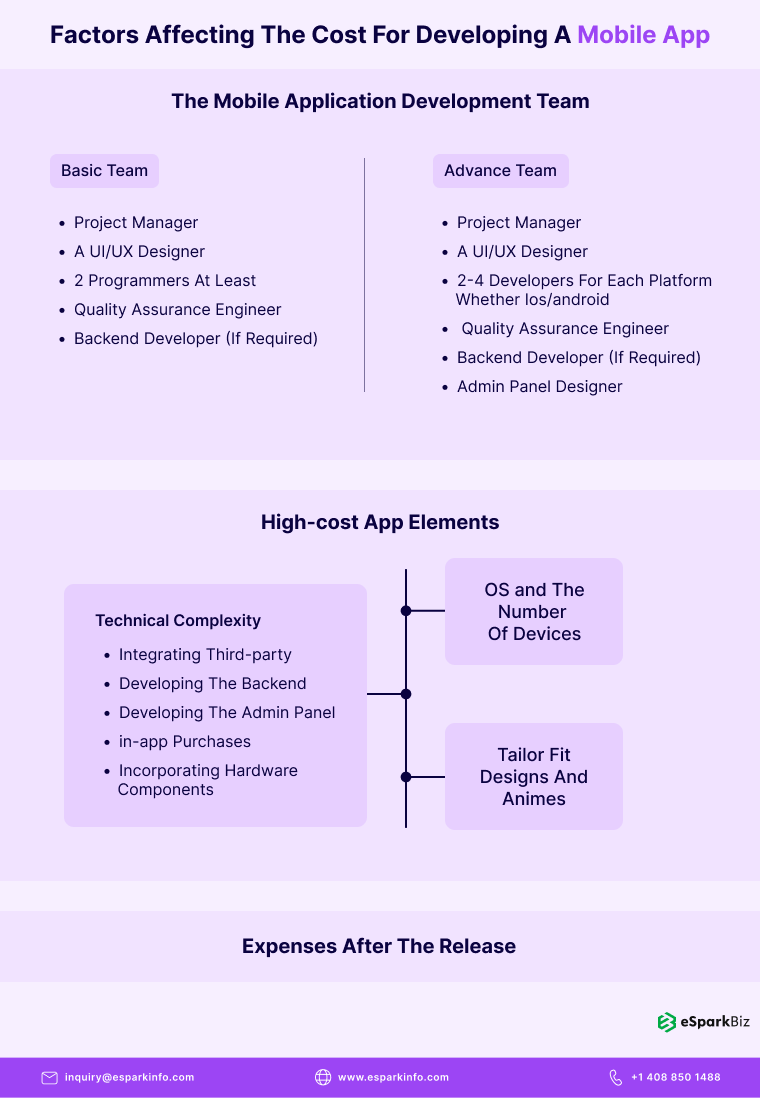
The Mobile App Development Team
The mobile app development team can be either basic or extended depending on the requirements of the project.
The members of a basic team are as follows:
- Project Manager
- A UI/UX Designer
- Two programmers, at least
- Quality Assurance Engineer
Note: If there is a requirement of a backend infrastructure for developing an API, then the team will have a backend developer as well.
The members of the extended team include:
- Admin Panel Designer
- 2-4 Developer for each platform, whether iOS/Android
- Project Manager
- A UI/UX Designer
- Quality Assurance Engineer
Note: If there is a requirement of a backend infrastructure for developing an API, then the team will have a backend developer as well.
High-Cost App Elements
The most crucial factor while calculating the app development costs is the complexity of the product.
The final costs are affected by the following three factors:
Technical Complexity
The more the app will have features to be incorporated, the more the project is added with technical complexities. I have penned down a few common examples:
Third-party Integration
A requirement for the integration of third-party libraries, frameworks, and services rise when functionalities like the implementation of the payment features are required. There will be a need for integrating services like Braintree or stripe.
If the app demands the addition of social media sharing capabilities then APIs like Facebook, Twitter, etc., come into the picture. Real-time chats are other factors of implementation into the app with the help of Actor, Layer, etc.
Developing The Backend
In tech lingo, a backend is representation of an OS. It provides an API for enabling data exchange between a mobile application and a database. In simple words, the app’s business logic is implemented by the backend.
Developing The Admin Panel
What makes it easier for operating apps, user and content management, viewing stats, and more?
The Admin Panel.⚙
It is a useful tool that manages all the above-mentioned tasks easily. The challenge is to find a top-quality, flexible admin template. Building a tailored-fit solution fitting to your business needs is much more efficient.
In-App Purchases

In-app purchases have various forms. Right from virtual goods to additional functionality, they can be implemented. They add technical complexity to the project due to a wide range of tasks included for implementing the in-app purchases.
Incorporating Hardware Components
Hardware components like gyroscopes, accelerometers, heart rate sensors, NFC, Bluetooth, GPS, barometers, and others come loaded with modern smartphones.
Depending on the type of device and the manufacturer, the hardware set varies. The factors that increase the development cost and time are searching for the right approach for each device and testing the communication of different hardware components with software.
OS And The Number Of Devices
For iOS
The iOS app is expected to be compatible with the latest and the previous iOS devices and support the latest and previous iOS versions.
For Android
Android apps are diversified.
Three factors influence our decision of which devices are supposed to support:
- The market size for the share of each Android device manufacturer.
- Market Specific Devices
- Preferences by the Clients
These factors influence the Android OS versions as well.
The more the number of devices, the more the time spent on the adoption of the application. The factors that are addressed here are screen sizes, resolutions, hardware specifications, and testing.
Note: If you choose to develop a mobile app for a popular Android device then the cost of building the app won’t be affected much.
Takeaway: Depending on the market for Android, the Android app development cost is much likely to exceed the cost to develop an iOS app development.
Tailor Fit Designs And Animes
The complexity of implementation arises when custom user interfaces try to make way for them. This increases the cost as compared to the cost of building a standard component.
Expenses After The Release
Your money isn’t utilized only on the programming part. It is also used to develop and scale up a product as well. The app requires upgrades, customer support, maintenance of the backend servers, cloud hosting, and legal support.
You need to invest in marketing and promotion as it makes a huge impact on the success of the product.
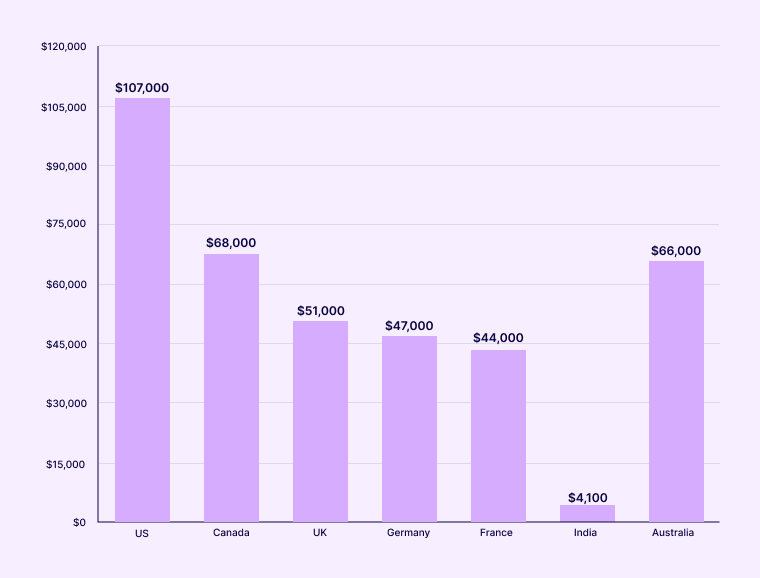
Mobile app developer annual salary, by country, in USD
The average hourly rates are provided below.
- US and Canadian-based companies: $50 to $250 per hour
- Australian agencies: $50-$150
- Western European and UK-based developers: $35 and $170
- Eastern Europeans: $20 – $150
- And Indian rates: $15-$80 per hour
How Long Does It Take To Build An App?
A general query often heard from the clients is, “How long will it take to make the app??” Well, there is no perfect time frame as there are several factors that drive the time requirement of a project.

I have listed them below:
The Scope Of The App
The first step in determining the time frame of developing a mobile app is outlining the scope of the app. This is required in the very first stage as incorporating additional features at a later stage becomes quite difficult and consumes a lot of time.
The scope of the project includes analyzing the requirements of the target audience, market research, competitor apps present in the market, and the demand of the apps which have a market share. The scope also includes what new can be done in the app if a similar app is present in the market.
Functions And Features Offered To The Users
The original question “How much time will it require? ⏳” depends on the number of services and features the app has in its kitty. The research includes the analysis of the app whether the market has a demand for solutions that the app has to offer the users.
The next step is the mode of operation. One has to accurately define how the app would play a role in managing and sourcing data in addition to the tasks it performs and the features and functionalities it would incorporate.
With increasing functions and features, the design time increases. Another important aspect is on how many OS platforms the app will be available for download.
I will wind up saying the average time required to build an app based on its scope, features and functionalities offered:
- A small app: The scoping process including the functions and features that have to be incorporated, might range from 1-2 weeks.
- A medium-sized app: It might take 2-3 weeks.
- A large-sized App: It will need nearly four weeks for defining the scope and requirement analysis.
Design And Development
The app’s feasibility in terms of the compatibility of the backend and front-end requires a lot of attention. Therefore the designers and the developers work in coordination.
Usually, The main concentration of the front-end designers and developers stays on aspects like wireframing, UI design & developing, and caching. The backend developers take charge of data-integration, data storage, versioning, and managing the users, among the other details.
Thus for seamless integration, it is necessary to work in coordination, which if not done, will cause unnecessary delays and hence have to go back and do rework.
If again we talk about the time limitations, it depends on the size and complexity of the app. For an app that is simple and small, it may take 3-4 weeks. Now, if the app is complex, it will need 9-10 weeks.
Testing
The testing phase is crucial because the apps have to be free from bugs before the launching of the app in app stores. The development team tests initially by finding errors and rectifying them continuously. But, this is not sufficient before the final launch. Therefore, beta testing is carried out to check technical glitches that the user may face.
Usually, beta testing might take around three weeks to a month. The reason is the number of iterations of debugging and retesting it might need.
Now, you have an idea what your project might cost and the amount of time it would require. In most cases, launching an app requires raising funds. So the next question arises:
How To Get Funding For Mobile Apps?
By now you must have an idea what your project might cost.
How to get funding for mobile apps??
Simple Tip: Raise the funds for a mobile app just like you raise for other purposes or business.

This tip depends on the following funding techniques:
Venture Capital
Venture Capitals or VCs are the ‘big fish’ of the funding world. They are into large investments, and therefore the possibility of getting a fund from them for your ideation makes sense, and you can dream about skyrocketing your start-up. Venture capitalists demand a lot of control on your business but have a great offering for mentorship in turn.
Known Sources, F&F Services
One of the most common funding sources is from friends and relatives. Friends & family(F&F) are always there for the rescue. The investors know you and therefore the initial investments made partially seek a return on investment.
But you need to take a serious note of this. You and your family know the investors. Just convince them about the ideation and how it would impact the market. Be very careful with every dollar you invest in this app.
Crowd-Funding
This is great and a viable option for funding your mobile app. This tact incorporates a large number of investors each offering a small contribution and raising funds. The mode of this practice is the internet and social media networks.
Social Media
Not having sufficient funds to initiate your idea won’t make you an inferior human being. Be loud about the fact that you need money. Social Media is one of the strongest platforms where you can share your ideas and attract people for funding into your project.
Connect with people around you who have the same interests. This may lead to a connection who would turn into an investor.
Intro Via Third-Party
Investors are very careful about their investments. Therefore you need to be very careful about how you present your idea and convince them. Prepare an elevator speech of about 30 seconds that will give a clear picture of your mobile app for which you are looking for investors.
Since the low-level investors too think a lot before investing in start-ups, an intro via a third party is profitable. For example, if a colleague of yours can introduce you to an investor he/she is aware of, then half of your battle is won.
Bootstrap
As it is said, “Save money and money will save you,?” your own saving can be the best option for your app if nothing works out. Working and fueling for your start-up in parallel is one of the most common methods. This is an ideal solution and extremely beneficial because with building a prototype product, you are validating your idea as well.
You can raise funds from an investment firm. However, for that purpose, you will need a proof and sizable user base. If you succeed in generating the revenue, then you might not be in need of an investor and thus have the entire control over your business.
App Contests
Young entrepreneurs get a world-class platform to present their innovative ideas to businessmen and a large crowd of investors through app contests. There will be a panel for judging the contest including venture capitalists and business experts. This extremely competitive platform is the best way to stand out in the crowd. You get nearly 20 minutes to keep your case in front of them.
By now, hope, you have a brief idea about Mobile app development, the purpose of developing a mobile app for your business, the factors that affect the cost of the mobile app, and how you can fund your app. Coming straight to the point, you don’t build an app for fun, do you?
You have plans to get a good return on your investment through mobile apps. You want to do business and earn a good profit. Here are a few tips for making money through your app. So next I will be answering the question:
How To Make Money From Your Mobile App?
After extensive research and exploration, I could say that there are several ways you can make your app a money making machine irrespective of offering it in a paid plan or free.

I have penned six most commonly used points to generate revenue from your app. To earn money from your app, there is no thumb rule. It solely depends on the quality of services you are providing.
In-App Advertising
Make your way for the easiest and popular way of making money with your app.
- How it works: Permit the advertisements to display on your app.
- What you get: Paid for the total number of impressions the ads make or click they are getting. You will get paid for the broad type of ads you offer.
- Trick: Video ad fetches you more money than a banner ad.
- Precaution: Survey whether the users are patient to bear a video or not.
- Keep in mind: Importance/significance should be the base to decide the duration of the video ad and the frequency.
- Serious Talk: No ads can fetch you money. Offering the upgrade version is all you have to do.
In-App Purchases
Make some room for the in-app purchases. With more relevancy to the user’s perspective, this tact offers a variety of services at a higher level which would be unlocked after an update.
- How it works: Offers an extra bonus, premium content, games with virtual currency, or upgrade after every level.
- What you give: Users will get consumables and non-consumables.
- What the stats have to say: More than 50% of the apps make use of in-app purchases for making money.
Takeaway: A freemium model offering advanced features only on upgradation.
Subscription
Highly effective and presentable money making tact, the subscription model is a deal that is fair for both the sides involved.
- How it Works: The app offers a subscription to all the users. The user will be able to access some of the contents for free. If they want to have more, then they need to subscribe.
- What you get: All the users will get value-added services. After subscription, depending on the plans they have chosen, they will get access to the contents.
Paid Apps
After spending almost all your savings on building an app, putting a tag of Paid Apps is justifiable. But as every coin has two sides, there are contradictory views on this as well.
As per research, if there is a price tag on your app, money-making will be difficult. The reason is people opt for free apps as compared to the paid ones.
Sponsorship
If you have a sponsor with the same market targets, then sponsorship will work for you.
- How this works: Get hold a right sponsor, white label your app, app design can be adapted for matching the brand of the sponsors.
- The role of the developer: The developer enters the picture as the niche app has to be developed for apps and users fully customized as per the requirements on behalf of the brand or company offering sponsorship.
- What you get: Existing web traffic, the loyalty of the brand, and an extended user base.
Affiliate Program
A common platform where affiliation brings advertisers and affiliates together.
- How it works-Normally, mobile advertisers are business people trying to do business by selling their products or services through mobile web. The role of affiliates is to bring advertising solely on performance-based to the advertisers.
- What you get-You can earn money by being a part of the mobile affiliate network. You can advertise relevant apps, various products, and services offered by the affiliates.
- Takeaway-Revenue is in the form of clicks per ad or installs. This would definitely give rise to your revenue generation.
Conclusion
There is no secret in Mobile app development. It is like an open book. Similar to other businesses, your ideation plays an important role.
The mobile app development lifecycle gives you a crystal clear scenario of how one has to move ahead to fulfill the desires. Another factor critically acclaimed is the funding from the mobile app development company India.
I have mentioned all the possible ways that you can adopt. The cost of mobile app development depends on the ideation and the time frame essential to fulfill it. This in-depth guide will serve all your purposes if you are thinking to go for mobile app development.

